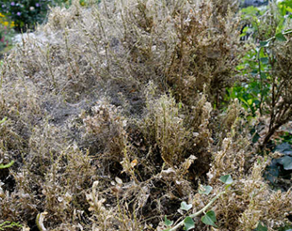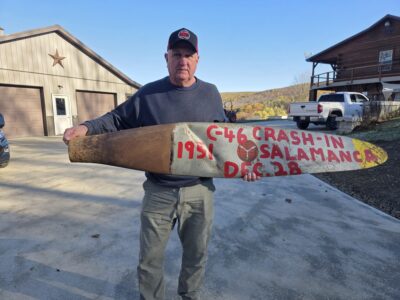Ag Officials Warn Of Box Tree Moth Spread

Pictured are plants that have been damaged by the box tree moth as well as webbing that is typical of a box tree moth infestation.
- Pictured are plants that have been damaged by the box tree moth as well as webbing that is typical of a box tree moth infestation.
- A box tree moth is pictured.
The box tree moth is an invasive pest that severely damages, and in some cases kills, boxwood plants if infestations go unmanaged. Home gardeners and landscapers are encouraged to learn more about the box tree moth and help stop the spread.
The box tree moth was first detected in Western New York in July 2021. Since then, established populations of the box tree moth have been reported in Erie County and Orleans County. The presence of the pest is new to Chautauqua County and puts boxwood plants at risk of infestation. Although boxwood is not native to the United States, it is a popular landscape plant and has been used ornamentally since the 1600s.
Box tree moths is most easily recognized by the webbing made by the caterpillars as they grow to maturity. This is often the first sign of detection. Other signs of early detection include chewed, cut, or “peeled” leaves, scattered green/black frass (caterpillar droppings), as well as dieback and browning from heavy feeding. Signs of damage may not be apparent at the beginning of infestation because young larvae hide amongst twigs and leaves. Severely infested shrubs often take on a brown or scorched look. As the foliage dwindles, the caterpillars will also feed on bark of stems, which leads to plant death.
The spread of BTM can occur both naturally and through human activity. To detect the pest, look for signs of damage, especially on the inside of the plant canopy. It’s imperative to inspect regularly, most importantly during active periods from March through October. The most effective strategy to stop an infestation from occurring is through early, proactive management. This includes hand picking larvae from lightly infested plants, and placing caterpillars in buckets of soapy water or freezing them in a sealed bag before disposal.

A box tree moth is pictured.
It’s also important to clear leaf litter and debris in the fall, particularly around infested plants to remove overwintering sites. Keeping boxwood plants healthy through proper pruning and watering will help to reduce plant stress and better support plant recovery from minor infestations. Such mechanical controls are useful in small gardens or during early stages of infestation. For more severe infestations, approved chemical applications can be used to rid boxwood of the pests.
If box tree moth is identified and detected in boxwood, proper disposal is crucial to reduce the spread of this pest. Those who remove infested plant material should:
– Double bag in plastic and place it with municipal waste. It is encouraged to allow sealed bags to sit in the sun for several days to ensure remaining larvae are killed before disposing.
– Do not compost at home or leave clippings for yard waste pick up. It is important to ensure all potential box tree moths are killed before disposing to not introduce the pest at new locations.
– Burning or deep burial may be an option- be sure to check with the municipality before doing so.
– Box tree moths must be destroyed before plant material can be moved. This may include double bagging or chemically treating before relocating.
The box tree moth is now a federally regulated species, and its distribution is very limited in New York. Those who detect box tree moth on their boxwood or suspect that it may be a box tree moth, report it to US Ag & Markets through their Box Tree Moth Public Report portal.





